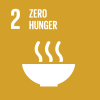
Average income of small-scale food producers, by sex and indigenous status
Last updated on 1 February 2022
This indicator is currently classified as Tier II. The Food and Agriculture Organization of the United Nations (FAO) is the main Custodian agency for this indicator in cooperation with the World Bank.
Unit of measure: Average annual income of small-scale food producers (in constant PPP 2011 USD) complemented by average income of large-scale food producers (in constant PPP 2011 USD)
Why is this indicator important?
This indicator measures the incomes of small-scale producers as a means of eliminating hunger and achieving other SDGs (e.g., poverty alleviation). Ending hunger requires long-term, sustainable food production systems and resilient agricultural practices. Developing efficient and robust food production programs to the boost agricultural productivity of small-scale producers is essential to maintain food supplies, increase incomes for poor and vulnerable groups, and feed the planet. It also contributes to strengthening rural development.
By tracking the income of small-scale producers by sex, community of reference, and enterprise size, data collected for indicator 2.3.2 enables governments to shape, prioritize, and invest in policies and measures that effectively boost agricultural productivity, drive economic growth, and eliminate hunger in particular for small-scale food producers, including women, Indigenous Peoples, family farmers, and pastoralists.
How is the indicator measured and monitored?
Data and information on income of small-scale producers is limited in many countries, but better accessible compared to the information available for indicator 2.3.1. Similarly, information is often collected at household level instead of food production unit level. The indictor can be disaggregated by sex, type of enterprise, and by community of reference.
According to the metadata brief, sources of information are either agricultural surveys, or agricultural modules in integrated household surveys (e.g., LSMS-ISA) organized by the national statistical agencies, with the necessary support from the World Bank, FAO and other international agencies. FAO has been working on computing the indicator for eight developing countries in Sub-Sahara Africa based on data collected from the Living Standards Measurement Study-Integrated Surveys on Agriculture (LSMS-ISA) surveys. Results have not been disseminated yet. In collaboration with IFAD and the World Bank, FAO also promotes the Agricultural and Rural Integrated Surveys project (AGRISurvey) which collects relevant data on an annual basis.
By Anne Hennings, peer-reviewed by FAO.
Official indicator data
The income from on-farm production activities includes income from crop production, livestock production, fisheries and aquaculture production, and from forestry production. The indicator is computed as annual income.
* Select "year" below to see the most recent data for more countries.
Other related indicators on Land Portal
In addition to the official indicator data, the following indicators provide information concerning the importance of agriculture in a given country or the distribution of land.
| Indicator | Min-Max Number of years |
Countries / Obs | Min / Max Value |
|---|---|---|---|
| Agriculture - Value Added | |||
| Employees in Agriculture - Female (% of female employment) | |||
| GDP per capita, PPP (constant 2011 international $) |
Pagination
Land institutions, investments, and income diversification: Pathways to economic development for Brazil’s quilombo communities
Efforts to distribute land titles to low-income rural Afro-Brazilian communities, known as quilombos, have been disappointing despite the provision of ample government resources. Until now, research on the implications of Brazil s land reform policies has not considered quilombo communities in an economic context.
Tenure (in)security and agricultural investment of smallholder farmers in Mozambique
Using the case of past and ongoing land tenure reforms in Mozambique, this paper aims at assessing the determinants of tenure security for households and the implications of such tenure security on their observed behavior in undertaking long-term land-related investments.
Implications of accelerated agricultural growth on household incomes and poverty in Ethiopia
Ethiopia’s national development strategy, A Plan for Accelerated and Sustained Development to End Poverty for 2005/06 to 2009/10 (PASDEP) places a major emphasis on achieving high rates of agricultural and overall economic growth.
Forest incomes after Uganda's forest sector reform
Forest sector governance reform is frequently promoted as a policy tool for achieving favorable livelihood outcomes in the low income tropics. However, there is a dearth of empirical evidence to support this claim, particularly at the household level. Drawing on the case of a major forest sector governance reform implemented in Uganda in 2003, this study seeks to fill that gap.
Impact of contract farming on income
Contract farming is seen by proponents as a way to raise small-farm income by delivering technology and market information to small farmers, incorporating them into remunerative new markets. Critics, however, see it as a strategy for agribusiness firms to pass production risk to farmers, taking advantage of an unequal bargaining relationship.
Pagination
![]()

By 2030, double the agricultural productivity and incomes of small-scale food producers, in particular women, indigenous peoples, family farmers, pastoralists and fishers, including through secure and equal access to land, other productive resources and inputs, knowledge, financial services, markets and opportunities for value addition and non-farm employment
Indicator details
The indicator is conceptually clear, has an internationally established methodology and standards are available, but data is not regularly produced by countries.
Key dates:





